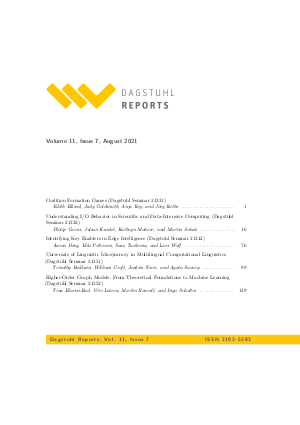Dagstuhl Reports, Volume 11, Issue 7
-
Part of:
Volume:
Dagstuhl Reports, Volume 11
Journal: Dagstuhl Reports (DagRep)

Event
- Dagstuhl Seminars 21331, 21332, 21342, 21351, 21352
Publication Details
- published at: 2021-12-22
- Publisher: Schloss Dagstuhl – Leibniz-Zentrum für Informatik
- DBLP: db/journals/dagstuhl-reports/dagstuhl-reports11
Access Numbers
- Detailed Access Statistics available here
-
Total Document Accesses (updated on a weekly basis):
0PDF Downloads
Documents
Dagstuhl Reports, Volume 11, Issue 7, August 2021, Complete Issue
Abstract
Cite as
Dagstuhl Reports, Volume 11, Issue 7, pp. 1-180, Schloss Dagstuhl – Leibniz-Zentrum für Informatik (2021)
Copy BibTex To Clipboard
@Article{DagRep.11.7,
title = {{Dagstuhl Reports, Volume 11, Issue 7, August 2021, Complete Issue}},
pages = {1--180},
journal = {Dagstuhl Reports},
ISSN = {2192-5283},
year = {2021},
volume = {11},
number = {7},
publisher = {Schloss Dagstuhl -- Leibniz-Zentrum f{\"u}r Informatik},
address = {Dagstuhl, Germany},
URL = {https://drops.dagstuhl.de/entities/document/10.4230/DagRep.11.7},
URN = {urn:nbn:de:0030-drops-155861},
doi = {10.4230/DagRep.11.7},
annote = {Keywords: Dagstuhl Reports, Volume 11, Issue 7, July 2021, Complete Issue}
}
Dagstuhl Reports, Table of Contents, Volume 11, Issue 7, 2021
Abstract
Cite as
Dagstuhl Reports, Volume 11, Issue 7, pp. i-ii, Schloss Dagstuhl – Leibniz-Zentrum für Informatik (2021)
Copy BibTex To Clipboard
@Article{DagRep.11.7.i,
title = {{Dagstuhl Reports, Table of Contents, Volume 11, Issue 7, 2021}},
pages = {i--ii},
journal = {Dagstuhl Reports},
ISSN = {2192-5283},
year = {2021},
volume = {11},
number = {7},
publisher = {Schloss Dagstuhl -- Leibniz-Zentrum f{\"u}r Informatik},
address = {Dagstuhl, Germany},
URL = {https://drops.dagstuhl.de/entities/document/10.4230/DagRep.11.7.i},
URN = {urn:nbn:de:0030-drops-155870},
doi = {10.4230/DagRep.11.7.i},
annote = {Keywords: Table of Contents, Frontmatter}
}
Coalition Formation Games (Dagstuhl Seminar 21331)
Abstract
Cite as
Edith Elkind, Judy Goldsmith, Anja Rey, and Jörg Rothe. Coalition Formation Games (Dagstuhl Seminar 21331). In Dagstuhl Reports, Volume 11, Issue 7, pp. 1-15, Schloss Dagstuhl – Leibniz-Zentrum für Informatik (2021)
Copy BibTex To Clipboard
@Article{elkind_et_al:DagRep.11.7.1,
author = {Elkind, Edith and Goldsmith, Judy and Rey, Anja and Rothe, J\"{o}rg},
title = {{Coalition Formation Games (Dagstuhl Seminar 21331)}},
pages = {1--15},
journal = {Dagstuhl Reports},
ISSN = {2192-5283},
year = {2021},
volume = {11},
number = {7},
editor = {Elkind, Edith and Goldsmith, Judy and Rey, Anja and Rothe, J\"{o}rg},
publisher = {Schloss Dagstuhl -- Leibniz-Zentrum f{\"u}r Informatik},
address = {Dagstuhl, Germany},
URL = {https://drops.dagstuhl.de/entities/document/10.4230/DagRep.11.7.1},
URN = {urn:nbn:de:0030-drops-155885},
doi = {10.4230/DagRep.11.7.1},
annote = {Keywords: Coalition Formation, Cooperative Games}
}
Understanding I/O Behavior in Scientific and Data-Intensive Computing (Dagstuhl Seminar 21332)
Abstract
Cite as
Philip Carns, Julian Kunkel, Kathryn Mohror, and Martin Schulz. Understanding I/O Behavior in Scientific and Data-Intensive Computing (Dagstuhl Seminar 21332). In Dagstuhl Reports, Volume 11, Issue 7, pp. 16-75, Schloss Dagstuhl – Leibniz-Zentrum für Informatik (2021)
Copy BibTex To Clipboard
@Article{carns_et_al:DagRep.11.7.16,
author = {Carns, Philip and Kunkel, Julian and Mohror, Kathryn and Schulz, Martin},
title = {{Understanding I/O Behavior in Scientific and Data-Intensive Computing (Dagstuhl Seminar 21332)}},
pages = {16--75},
journal = {Dagstuhl Reports},
ISSN = {2192-5283},
year = {2021},
volume = {11},
number = {7},
editor = {Carns, Philip and Kunkel, Julian and Mohror, Kathryn and Schulz, Martin},
publisher = {Schloss Dagstuhl -- Leibniz-Zentrum f{\"u}r Informatik},
address = {Dagstuhl, Germany},
URL = {https://drops.dagstuhl.de/entities/document/10.4230/DagRep.11.7.16},
URN = {urn:nbn:de:0030-drops-155891},
doi = {10.4230/DagRep.11.7.16},
annote = {Keywords: I/O performance measurement, Understanding user I/O patterns, HPC I/O, I/O characterization}
}
Identifying Key Enablers in Edge Intelligence (Dagstuhl Seminar 21342)
Abstract
Cite as
Aaron Ding, Ella Peltonen, Sasu Tarkoma, and Lars Wolf. Identifying Key Enablers in Edge Intelligence (Dagstuhl Seminar 21342). In Dagstuhl Reports, Volume 11, Issue 7, pp. 76-88, Schloss Dagstuhl – Leibniz-Zentrum für Informatik (2021)
Copy BibTex To Clipboard
@Article{ding_et_al:DagRep.11.7.76,
author = {Ding, Aaron and Peltonen, Ella and Tarkoma, Sasu and Wolf, Lars},
title = {{Identifying Key Enablers in Edge Intelligence (Dagstuhl Seminar 21342)}},
pages = {76--88},
journal = {Dagstuhl Reports},
ISSN = {2192-5283},
year = {2021},
volume = {11},
number = {7},
editor = {Ding, Aaron and Peltonen, Ella and Tarkoma, Sasu and Wolf, Lars},
publisher = {Schloss Dagstuhl -- Leibniz-Zentrum f{\"u}r Informatik},
address = {Dagstuhl, Germany},
URL = {https://drops.dagstuhl.de/entities/document/10.4230/DagRep.11.7.76},
URN = {urn:nbn:de:0030-drops-155906},
doi = {10.4230/DagRep.11.7.76},
annote = {Keywords: artificial intelligence, communication networks, edge computing, intelligent networking}
}
Universals of Linguistic Idiosyncrasy in Multilingual Computational Linguistics (Dagstuhl Seminar 21351)
Abstract
Cite as
Timothy Baldwin, William Croft, Joakim Nivre, and Agata Savary. Universals of Linguistic Idiosyncrasy in Multilingual Computational Linguistics (Dagstuhl Seminar 21351). In Dagstuhl Reports, Volume 11, Issue 7, pp. 89-138, Schloss Dagstuhl – Leibniz-Zentrum für Informatik (2021)
Copy BibTex To Clipboard
@Article{baldwin_et_al:DagRep.11.7.89,
author = {Baldwin, Timothy and Croft, William and Nivre, Joakim and Savary, Agata},
title = {{Universals of Linguistic Idiosyncrasy in Multilingual Computational Linguistics (Dagstuhl Seminar 21351)}},
pages = {89--138},
journal = {Dagstuhl Reports},
ISSN = {2192-5283},
year = {2021},
volume = {11},
number = {7},
editor = {Baldwin, Timothy and Croft, William and Nivre, Joakim and Savary, Agata},
publisher = {Schloss Dagstuhl -- Leibniz-Zentrum f{\"u}r Informatik},
address = {Dagstuhl, Germany},
URL = {https://drops.dagstuhl.de/entities/document/10.4230/DagRep.11.7.89},
URN = {urn:nbn:de:0030-drops-155911},
doi = {10.4230/DagRep.11.7.89},
annote = {Keywords: computational linguistics, morphosyntax, multiword expressions, language universals, idiosyncrasy}
}
Higher-Order Graph Models: From Theoretical Foundations to Machine Learning (Dagstuhl Seminar 21352)
Abstract
Cite as
Tina Eliassi-Rad, Vito Latora, Martin Rosvall, and Ingo Scholtes. Higher-Order Graph Models: From Theoretical Foundations to Machine Learning (Dagstuhl Seminar 21352). In Dagstuhl Reports, Volume 11, Issue 7, pp. 139-178, Schloss Dagstuhl – Leibniz-Zentrum für Informatik (2021)
Copy BibTex To Clipboard
@Article{eliassirad_et_al:DagRep.11.7.139,
author = {Eliassi-Rad, Tina and Latora, Vito and Rosvall, Martin and Scholtes, Ingo},
title = {{Higher-Order Graph Models: From Theoretical Foundations to Machine Learning (Dagstuhl Seminar 21352)}},
pages = {139--178},
journal = {Dagstuhl Reports},
ISSN = {2192-5283},
year = {2021},
volume = {11},
number = {7},
editor = {Eliassi-Rad, Tina and Latora, Vito and Rosvall, Martin and Scholtes, Ingo},
publisher = {Schloss Dagstuhl -- Leibniz-Zentrum f{\"u}r Informatik},
address = {Dagstuhl, Germany},
URL = {https://drops.dagstuhl.de/entities/document/10.4230/DagRep.11.7.139},
URN = {urn:nbn:de:0030-drops-155929},
doi = {10.4230/DagRep.11.7.139},
annote = {Keywords: (Social) Network analysis, Graph mining, Graph theory, Network science, Machine Learning, Statistical relational learning, Topological data analysis}
}